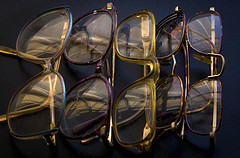 Nearsightedness is a vision impairment in which faraway objects are out of focus but objects near are viewed clearly. It is caused by an overly curved cornea or excessively long eyeball. There are several kinds of nearsighted glasses available to cure this condition.
Nearsightedness is a vision impairment in which faraway objects are out of focus but objects near are viewed clearly. It is caused by an overly curved cornea or excessively long eyeball. There are several kinds of nearsighted glasses available to cure this condition.
Corrective eye glasses cure nearsightedness by canceling out the enhanced cornea curve or the extended eye length. Corrective lenses include contact lenses and eyeglasses. The single vision lens restores or establishes normal sight regardless if the object is blurry at a distance or fuzzy when near. Bifocal lenses may be prescribed when nearsightedness is caused by an activity that demands near-vision work or when the patient is more than forty years of age.
Multifocal lenses provide different strengths within the lens that could allow for a focused vision off at a distance while providing visual clarity on objects that are nearby. There are several nearsighted persons who get more focus from contact lenses instead of the traditional eyeglasses. There is a wide range of contact lenses available, including soft and hard lenses, extended wear lenses which are designed for one week non-stop use, disposable lenses which are more costly, rigid gas permeable that offers less irritation and durability and bifocal lenses.